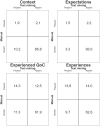Comparing text mining and manual coding methods: Analysing interview data on quality of care in long-term care for older adults
- PMID: 37939098
- PMCID: PMC10631650
- DOI: 10.1371/journal.pone.0292578
Comparing text mining and manual coding methods: Analysing interview data on quality of care in long-term care for older adults
Abstract
Objectives: In long-term care for older adults, large amounts of text are collected relating to the quality of care, such as transcribed interviews. Researchers currently analyze textual data manually to gain insights, which is a time-consuming process. Text mining could provide a solution, as this methodology can be used to analyze large amounts of text automatically. This study aims to compare text mining to manual coding with regard to sentiment analysis and thematic content analysis.
Methods: Data were collected from interviews with residents (n = 21), family members (n = 20), and care professionals (n = 20). Text mining models were developed and compared to the manual approach. The results of the manual and text mining approaches were evaluated based on three criteria: accuracy, consistency, and expert feedback. Accuracy assessed the similarity between the two approaches, while consistency determined whether each individual approach found the same themes in similar text segments. Expert feedback served as a representation of the perceived correctness of the text mining approach.
Results: An accuracy analysis revealed that more than 80% of the text segments were assigned the same themes and sentiment using both text mining and manual approaches. Interviews coded with text mining demonstrated higher consistency compared to those coded manually. Expert feedback identified certain limitations in both the text mining and manual approaches.
Conclusions and implications: While these analyses highlighted the current limitations of text mining, they also exposed certain inconsistencies in manual analysis. This information suggests that text mining has the potential to be an effective and efficient tool for analysing large volumes of textual data in the context of long-term care for older adults.
Copyright: © 2023 Hacking et al. This is an open access article distributed under the terms of the Creative Commons Attribution License, which permits unrestricted use, distribution, and reproduction in any medium, provided the original author and source are credited.
Conflict of interest statement
The authors have declared that no competing interests exist.
Figures


References
-
- Sion K, Verbeek H, de Vries E, Zwakhalen S, Odekerken-Schröder G, Schols J, et al. The feasibility of connecting conversations: A narrative method to assess experienced quality of care in nursing homes from the resident’s perspective. International Journal of Environmental Research and Public Health. 2020;17: 5118. doi: 10.3390/ijerph17145118 - DOI - PMC - PubMed
-
- Sion KY, Haex R, Verbeek H, Zwakhalen SM, Odekerken-Schröder G, Schols JM, et al. Experienced quality of post-acute and long-term care from the care recipient’s perspective–a conceptual framework. Journal of the American Medical Directors Association. 2019;20: 1386–1390. doi: 10.1016/j.jamda.2019.03.028 - DOI - PubMed
-
- Strauss A, Corbin J. Basics of qualitative research techniques. Sage publications; Thousand Oaks, CA; 1998.
MeSH terms
LinkOut - more resources
Full Text Sources

